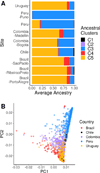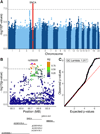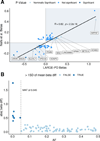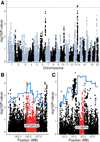Characterizing the Genetic Architecture of Parkinson's Disease in Latinos
- PMID: 34227697
- PMCID: PMC8457043
- DOI: 10.1002/ana.26153
Characterizing the Genetic Architecture of Parkinson's Disease in Latinos
Abstract
Objective: This work was undertaken in order to identify Parkinson's disease (PD) risk variants in a Latino cohort, to describe the overlap in the genetic architecture of PD in Latinos compared to European-ancestry subjects, and to increase the diversity in PD genome-wide association (GWAS) data.
Methods: We genotyped and imputed 1,497 PD cases and controls recruited from nine clinical sites across South America. We performed a GWAS using logistic mixed models; variants with a p-value <1 × 10-5 were tested in a replication cohort of 1,234 self-reported Latino PD cases and 439,522 Latino controls from 23andMe, Inc. We also performed an admixture mapping analysis where local ancestry blocks were tested for association with PD status.
Results: One locus, SNCA, achieved genome-wide significance (p-value <5 × 10-8 ); rs356182 achieved genome-wide significance in both the discovery and the replication cohorts (discovery, G allele: 1.58 OR, 95% CI 1.35-1.86, p-value 2.48 × 10-8 ; 23andMe, G allele: 1.26 OR, 95% CI 1.16-1.37, p-value 4.55 × 10-8 ). In our admixture mapping analysis, a locus on chromosome 14, containing the gene STXBP6, achieved significance in a joint test of ancestries and in the Native American single-ancestry test (p-value <5 × 10-5 ). A second locus on chromosome 6, containing the gene RPS6KA2, achieved significance in the African single-ancestry test (p-value <5 × 10-5 ).
Interpretation: This study demonstrated the importance of the SNCA locus for the etiology of PD in Latinos. By leveraging the demographic history of our cohort via admixture mapping, we identified two potential PD risk loci that merit further study. ANN NEUROL 2021;90:353-365.
© 2021 American Neurological Association.
Conflict of interest statement
Potential Conflict of Interest:
The authors do not declare any potential conflicts of interest.
Figures




Comment in
-
Genetic Studies of Parkinson's and Alzheimer's Disease in Latinos/Hispanics: New Insights and Challenges.Ann Neurol. 2021 Sep;90(3):350-352. doi: 10.1002/ana.26179. Epub 2021 Aug 4. Ann Neurol. 2021. PMID: 34309075 No abstract available.
-
Improving Diversity in Parkinson's Disease Genetics: Findings from the First-Ever Genome-Wide Association Study in Latinos.Mov Disord. 2021 Nov;36(11):2505. doi: 10.1002/mds.28782. Epub 2021 Sep 2. Mov Disord. 2021. PMID: 34476843 No abstract available.
References
Publication types
MeSH terms
Grants and funding
LinkOut - more resources
Full Text Sources
Medical
Miscellaneous

